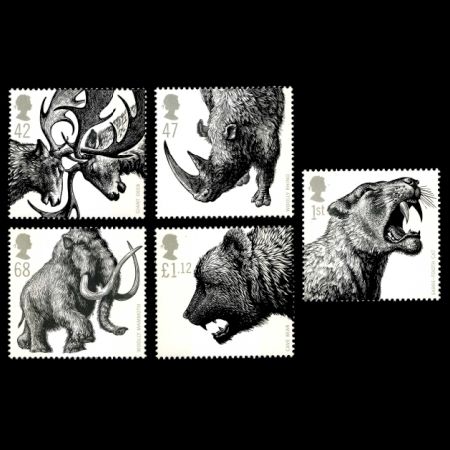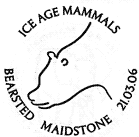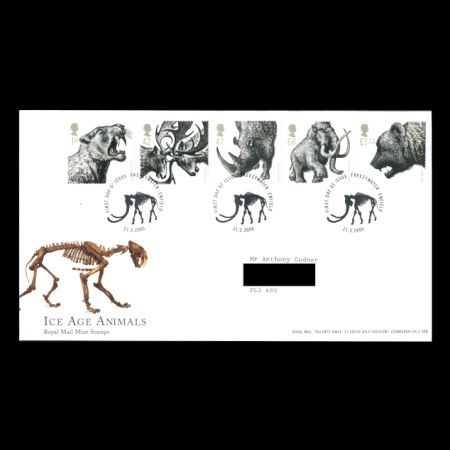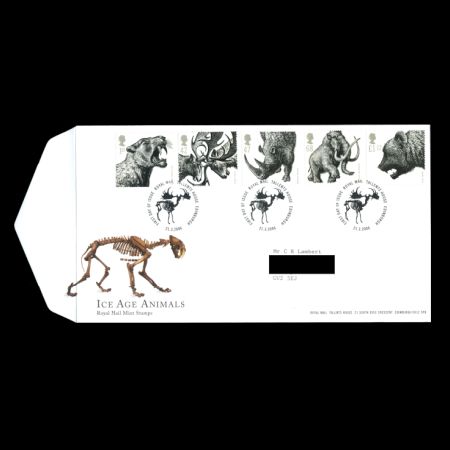United Kingdom 2006 "Ice Age Animals"
| << prev | back to index | next >> |
| Issue Date | 21.03.2006 |
| ID | Michel: 2391-2395 Scott: 2359-2363 Stanley Gibbons: 2615-2619 Yvert: UPU: GB029.06 Category: pF |
| Author | designed by Howard Brown with illustrations by Andrew Davidson |
| Stamps in set | 5 |
| Value | 1st class - sabre
tooth cat (Homotherium latidens) 42p - giant deer (Megaloceros giganteus) 47p - woolly rhino (Coelodonta antiquitatis) 69p - woolly mammoth (Mammuthus primigenius) 1.12 - cave bear (Ursus spelaus) |
| Size (width x height) | 37x35mm |
| Layout | Sheets of 25 and 50 stamps |
| Products | FDC x many MC PP x1 |
| Paper | |
| Perforation | 14x14.5 |
| Print Technique | lithography |
| Printed by | Joh Enschede Security Prin |
| Quantity | |
| Issuing Authority | Royal Mail of Great Britain |

The Royal Mail have launched a special set of new stamps featuring hairy - and scary - from the ice age which began around 2 million years ago. The set features the giant deer, sabre tooth cat, woolly rhino, cave bear, and woolly mammoth. Remains of all of the creatures have been found across the UK, including a woolly rhino fossil under London's Battersea Power Station and a woolly mammoth under The Strand in London.
The Royal Mail worked with the Natural History Museum to produce the stamps and the beautifully detailed engravings are the work of Andrew Davisdson. Andy Currant, Ice Age Mammals expert at the Natural History Museum, said 'we're discovering new evidence about the Ice Age all the time, and it's fantastic that the stamps show the public some of the animals that roamed these shores.' 'At the Natural History Museum we have the best collection of Ice Age mammal fossils in the UK and, working with experts from other institutions, we're using our resources to try to put together this piece of unwritten history'.
The creatures were reproduced into spectacular ice sculptures for the launch of the stamp set at the Natural History Museum. Royal Mail's Head of Special Stamps, Julietta Edgar, said: "I'm delighted that millions of people will get the chance to see some of these amazing animals once again, but this time from the safety of a stamp!"
Creatures from different time periods are just one of many things depicting on the stamps you will find in a philatelists collection. Some stamp collectors have collected so many of these stamps over the years that modifications to their home or office may be necessary to not only store but to properly display their stamp collection. Collectors may turn to a Home Advisor or other specialist to make an changes or improvements to their home to accommodate their large and growing collections.

(Homotherium latidens) There were many different species of sabre-tooth cat around the world; all are now extinct. The last European species, Homotherium, died out about 400,000 years ago. Although overall about the size of a lion, it had a long neck and relatively long front legs, which together with muscular forequarters made the animal look more like a hyena than a cat. It pursued prey such as horses and young mammoths, and used the long canine teeth - strongly flattened and quite fragile - to press into captured prey rather than to capture or stab at them. |

(Megaloceros giganteus) Giant deer had the largest antlers of any known deer, living or extinct. They grew in size and complexity through the animal's youth, typically reaching a span of 2.5-3.5 metres in large stags. Shed each year in the spring, they were grown through the summer, and used in fighting during late autumn and winter. These huge deer reached around 1.8 m height at the shoulder and weighed around 500 kg. The giant deer lived in small herds and was not an abundant species, perhaps because growing the huge antlers restricted it to areas of mineral-rich vegetation. The last ones died out only 7,000 years ago in western Siberia. |

(Coelodonta antiquitatis) DNA extracted from frozen carcasses has shown that the woolly rhino was most closely related to the living Sumatran rhinoceros. It had a body weight of about 2 tons, a massive shoulder with a height of about 1.8 metres, and a thick mane. The extraordinary front horn was typically 1.2m long, and very flattened. Close examination reveals that the front edge had a 'keel', suggesting active side-to-side movements of the head, perhaps for snow-clearing. Like living rhinos, the woolly rhino was probably solitary or lived in small groups. |

(Mammuthus primigenius) Contrary to popular belief, the woolly mammoth was no larger than living elephants, but with a domed head, sloping back, thick, hairy coat and enormous spirally curved tusks. It also had tiny ears and a very short tail - probably to minimise heat loss or frostbite. Stomach remains preserved in some Siberian carcasses show that the diet was 90% grass, plus mosses, ferns, and some shrub browse. Living in an open habitat, it is likely that herds often accumulated into hundreds or even thousands of animals, but within this smaller family structures, as in living elephants, still remained. |

(Ursus spelaus) Fossils of this extinct species have been found only in the middle and southern latitudes of the European continent. A bear of very large size - larger than the American grizzly - it was also marked out by a very pronounced 'step' shape of the forehead. Some caves in central and eastern Europe have yielded vast quantities of remains - up to 30,000 individuals in one Austrian cave alone. While most species of the bear family are omnivorous, recent biochemical analyses of fossil bones confirm that the cave bear was an exclusive vegetarian. | |
Official post marks.
|
| ||
|
A pictorial postmark from Royal Mail Tallents
House, 21 South Gyle Crescent, Edinburgh EH12 9PB will be used for the
issue. The reference number for the Tallents House, Edinburgh pictorial
postmark is as follows:- |
As an alternative to the Tallents House, Edinburgh postmark, pictorial and non-pictorial (plain design) FREEZYWATER, ENFIELD postmarks will also be available for this issue. |
All First Day Covers obtained from Post Offices
will bear the pictorial FREEZYWATER, ENFIELD postmark. |
|
Ref FD609 |
Ref FD610 |
Ref FD610NP |

|
References
Norvic Philatelics Natural History Museum Royal Mail of Great Britain Wikipedia| << prev | back to index | next >> |
Last update 24.12.2017
Any feedback, comments or even complaints are welcome: admin@paleophilatelie.eu (you can email me on ENglish, DEutsch, or RUssian)





















